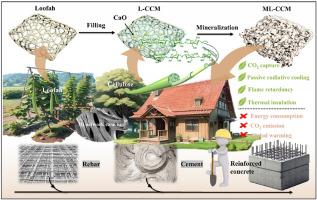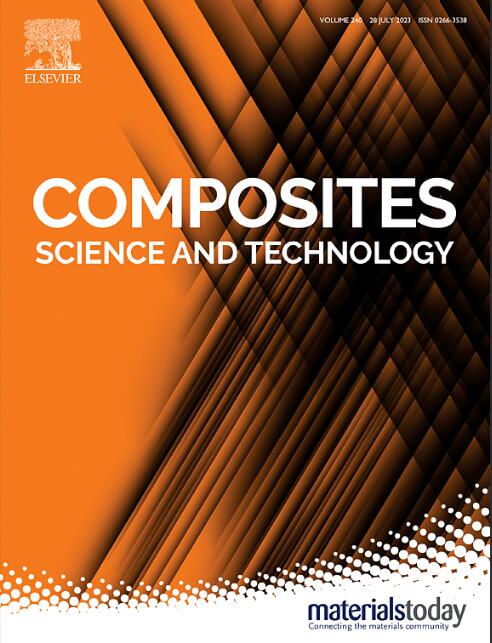具有多层结构的坚固矿化纤维素复合材料的 "钢筋混凝土 "设计,可有效捕获二氧化碳并具有被动辐射冷却能力
IF 9.8
1区 材料科学
Q1 MATERIALS SCIENCE, COMPOSITES
引用次数: 0
摘要
建筑业通过满足社会的住房需求促进了国家的经济发展。然而,该行业的能源消耗和二氧化碳(CO2)排放是导致全球变暖的主要因素。传统的建筑材料已无法满足可持续发展的要求,而天然纤维素可以作为一种新型的碳捕获建筑材料。受 "钢筋混凝土 "方法的启发,通过真空填充和原位矿化的策略,制造出了矿化纤维素复合材料(ML-CCM),形成了多层次结构的复合材料(天然微孔三维支架丝瓜络作为 "钢筋",纤维素填料作为 "水泥",在复合材料中交错排列)。由于三维支架丝瓜络起到了 "螺纹钢 "的作用,因此制成的 ML-CCM1 显示出明显较高的挠曲应变(约为不含丝瓜络的纤维素复合材料的 215.9%)。此外,由于 "水泥 "中含有微纳米 ZnO 颗粒,该复合材料还具有阻燃性能,在 90 ℃ 下具有优异的隔热性能和被动辐射冷却性能。此外,由孔隙和微纳米颗粒组成的多层次结构使其能够有效吸附二氧化碳和烟草烟雾。因此,生命周期评估结果表明,这种复合材料的全球变暖潜能值较低。因此,这项工作报告了一种具有二氧化碳捕获功能的三维生物基复合材料,在建筑行业节能减碳方面大有可为。本文章由计算机程序翻译,如有差异,请以英文原文为准。

“Reinforced concrete” design of robust mineralized cellulose composite with multilayered structure for efficient CO2 capture and passive radiative cooling ability
The construction industry promotes the economic development of the country by addressing society's housing needs. However, the industry's energy consumption and carbon dioxide (CO2) emissions are the primary contributors to global warming. Traditional building materials are no longer capable of meeting the requirements of sustainable development, while natural cellulose can be used as a new type of carbon capture construction material. Inspired by the “reinforced concrete” methodology, a mineralized cellulose composite (ML-CCM) was fabricated through a strategy of vacuum filling and in-situ mineralization, resulting in a composite with a multi-level structure (a natural microporous 3D scaffold loofah as “rebar” and cellulose filler as “cement” are staggered in the composite). The resultant ML-CCM1 exhibited a significantly high flexural strain (approximately 215.9 % of that of cellulose composite without loofah) because of the 3D scaffold loofah acting as a “rebar”. Furthermore, the composite possesses flame retardancy, superior thermal insulation at 90 °C, and passive radiative cooling performance due to the micro-nano ZnO particle in the “cement”. Moreover, the multi-level structure, consisting of pores and micro-nano particles, enables it to effectively adsorb CO2 and environment tobacco smoke. As a result, lifecycle assessments underscore the composite's low Global Warming Potential. Therefore, this work reports a promising 3D bio-based composite with CO2 capture for energy conservation and carbon reduction in the construction industry.
求助全文
通过发布文献求助,成功后即可免费获取论文全文。
去求助
来源期刊

Composites Science and Technology
工程技术-材料科学:复合
CiteScore
16.20
自引率
9.90%
发文量
611
审稿时长
33 days
期刊介绍:
Composites Science and Technology publishes refereed original articles on the fundamental and applied science of engineering composites. The focus of this journal is on polymeric matrix composites with reinforcements/fillers ranging from nano- to macro-scale. CSTE encourages manuscripts reporting unique, innovative contributions to the physics, chemistry, materials science and applied mechanics aspects of advanced composites.
Besides traditional fiber reinforced composites, novel composites with significant potential for engineering applications are encouraged.
 求助内容:
求助内容: 应助结果提醒方式:
应助结果提醒方式:


